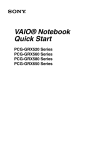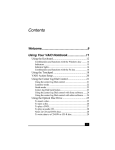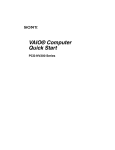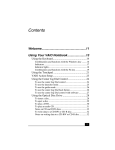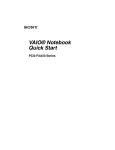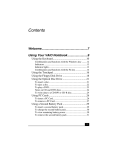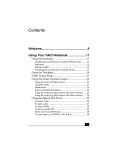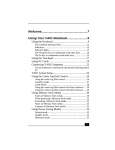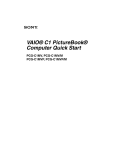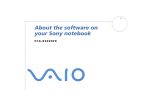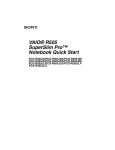Download VAIO Notebook Quick Start - Manuals, Specs & Warranty
Transcript
VAIO® Notebook Quick Start PCG-GRX500 Series Contents Welcome.......................................................5 Unpacking Your Notebook .........................................7 Registering Your Notebook ........................................9 Setting Up Your Dial-Up Connection .......................10 Setting Up Your VAIO® Notebook ...........15 Locating Controls and Ports ......................................16 Connecting a Power Source ......................................21 Starting Your Notebook ............................................27 Shutting Down Your Notebook.................................28 Adding Memory .........................................31 Precautions and Procedures.......................................32 Typical expansion memory configuration.................33 Removing a memory module ....................................34 Installing a memory module......................................36 Viewing the amount of memory................................37 About the Software on Your Notebook ...39 Software Overview....................................................40 Application, Driver, and System Recovery CDs.......47 Using Your Recovery CDs........................................48 3 VAIO® Notebook Quick Start Troubleshooting........................................55 Getting Help...............................................61 Support Options ........................................................ 62 Software Support Information .................................. 64 Index...........................................................67 4 Welcome Congratulations on your purchase of the Sony VAIO® notebook. Sony has combined leading-edge technology in audio, video, computing, and communications to provide you with state-of-the-art personal computing. Features ✍ For a complete description of the specifications of your VAIO® notebook, see the Specifications flyer supplied with your notebook. ❑ Exceptional performance — Your notebook includes a Mobile Intel® Pentium® 4 processor-M that supports Enhanced Intel® SpeedStep™ technology* and a V.90 compatible modem.† To combine performance and portability, Sony has implemented speed-controlling technology designed to maximize battery life during mobile computer use. Windows® reported actual CPU speed may not reflect the maximum CPU speed.‡ ❑ Wireless LAN capability — A Wireless LAN PC Card is supplied with selected models. For more information on using the wireless capability, see the online User Guide. ❑ Portability — Rechargeable battery pack provides hours of use without AC power. ❑ Sony audio and video quality — High-quality MPEG1/MPEG2 video, which supports full-screen display and enables you to take advantage of today’s advanced multimedia applications, games, and entertainment software. * The processor may be reduced to a lower operating speed under certain conditions. † Actual upload and download speeds may vary due to line conditions, ISP support, and government regulations. ‡ Depending on the specific model you purchased, speed-controlling technology may not be present. 5 VAIO® Notebook Quick Start ❑ Multimedia features — Enjoy the stereo speakers or use a pair of headphones (not supplied) to listen to audio CDs and DVDs. ❑ Microsoft® Windows® operating system — Your system includes Microsoft® Windows® XP Professional, Microsoft® Windows® XP Home Edition, or Microsoft® Windows® 2000 Professional. ❑ Communications — Access popular online services, send e-mail, browse the Internet, and use fax features. ❑ Optical drive (CD-RW/DVD Combo or DVD-ROM) — Your system includes either a CD-RW/DVD Combo Drive or a DVD-ROM drive. The CD-RW/DVD Combo Drive utilizes a new optical storage technology that combines the features of both a CD-RW drive and DVD-ROM drive, providing increased storage capacity and a rich multimedia computing experience. Optical drives play most DVD-ROM, DVD-R, CD-ROM, CDRW, and CD-R discs. This drive is hot-swappable. ✍ Your computer’s optical disc drive and other parts may differ depending on the model you purchased. 6 Unpacking Your Notebook Unpacking Your Notebook Remove the following hardware items from the box: Main unit* Power cord AC adapter Rechargeable battery pack Weight saver * The removable optical disc drive is preinstalled in your notebook. Documents ❑ VAIO® Notebook User Guide — A searchable online help file that contains detailed information on how to use your new notebook. (Windows XP) Press Start on the Windows® taskbar, select VAIO Help and Support, and click VAIO User Guide to open this file. (Windows 2000) Press Start, select VAIO Help Center, and VAIO Documentation. ❑ VAIO® Notebook Quick Start — Contains information on unpacking and setting up your notebook, supplementary updates, and software information. ❑ Microsoft® Windows® manual — Explains how to use the basic features of this latest Windows operating system. 7 VAIO® Notebook Quick Start ❑ VAIO® Notebook Notes on Use — Explains notes on use and offers safety tips. ❑ VAIO® Notebook Specifications flyer — Details the hardware specifications for your notebook. Software CDs ❑ Microsoft® Word — Enables you to reinstall Microsoft Word to the VAIO® notebook you purchased. Recovery CDs ❑ Application Recovery CD(s) — Enables you to reinstall individual applications if they become corrupted or are erased. ❑ Driver Recovery CD(s) — Enables you to reinstall individual device drivers if they become corrupted or are erased. ❑ System Recovery CD(s) — Enables you to restore the operating system and software that shipped with your computer if they become corrupted or are erased. Other ❑ Packet containing special product offers ❑ Warranty Card 8 Registering Your Notebook Registering Your Notebook Take advantage of Sony’s commitment to quality customer support and receive these benefits by registering your notebook: ❑ Sony Customer Support — Talk to a Support Representative to troubleshoot problems you may be having with your notebook. ❑ Limited Warranty — Protect your investment. See the Warranty Card for more details. ✍ You are prompted to register your computer the first time you turn on the unit. Follow the on-screen instructions to complete the registration process. If you are not able to register your computer during the first session, you are provided with additional registration opportunities later. 9 VAIO® Notebook Quick Start Setting Up Your Dial-Up Connection This section describes the basic steps for setting up your dial-up connection for the first time. The Connection Wizard guides you through the process of connecting to the Internet and then choosing an Internet Service Provider (ISP) or setting up an existing account. Setting up your dial-up connection (Windows® XP Home Edition/Windows® XP Professional) 1 Click Start from the Windows taskbar and select All Programs. 2 Point to Accessories, Communications, and then click New Connection Wizard. The Location Information window appears. Location Information window 3 10 Follow the instructions on-screen and then click OK to continue. The Phone and Modem Options window appears. Setting Up Your Dial-Up Connection Phone and Modem Options window 4 Select the location from where you are dialing and then click OK. The New Connection Wizard appears. 11 VAIO® Notebook Quick Start New Connection Wizard 5 12 Follow the on-screen instructions to finish setting up your dial-up connection. Setting Up Your Dial-Up Connection (Windows® 2000 Professional) 1 Double-click the Connect to the Internet icon on the Windows desktop. The Internet Connection Wizard appears. Internet Connection Wizard 2 Follow the on-screen instructions to finish setting up your dial-up connection and to choose your ISP. 13 VAIO® Notebook Quick Start 14 Setting Up Your VAIO® Notebook This section describes all the controls and ports on your notebook, how to connect your notebook to a power source, and how to start and shut down your notebook. ❑ Locating Controls and Ports ❑ Connecting a Power Source ❑ Starting Your Notebook ❑ Shutting Down Your Notebook 15 VAIO® Notebook Quick Start Locating Controls and Ports Front 4 1 2 Memory Stick® indicator Num Lock indicator 8 9 3 4 5 6 7 Caps Lock indicator Scroll Lock indicator Power indicator Battery 1 indicator Battery 2 indicator 10 11 12 13 14 16 Hard disk drive indicator LCD (Liquid Crystal Display) screen Keyboard Speakers Left and right buttons Touchpad Power button Locating Controls and Ports Left 1 2 3 4 5 PC Card slots Back button for center Jog Dial™ control Center Jog Dial™ control CD-RW/DVD Combo Drive or DVD-ROM drive in multipurpose bay* Eject button 6 7 Manual eject button Memory Stick® slot 8 9 USB port i.LINK® (IEEE 1394) S400 port * This multipurpose bay can house either an optical disc drive or an optional second battery. 17 VAIO® Notebook Quick Start Right 1 2 3 4 5 Drive bay with hard disk drive Battery bay Headphone jack Microphone jack* USB port * There is a protruding dot above the Microphone jack to further distinguish it from other jacks and ports. Do not connect a microphone to the Headphone jack. 18 Locating Controls and Ports Back 1 2 3 4 Air vent DC In port Ethernet port VGA port 5 6 7 8 Printer port USB port AV Out jack Phone line jack Only connect 10BASE-T and 100BASE-TX cables to the Ethernet port. Do not connect any other type of network cable or any telephone line. Connecting cables other than those listed above may result in an electric current overload and could cause a malfunction, excessive heat, or fire in the port. To connect the unit to the network, contact your network administrator. ✍ There is a ventilation slot located on the left side of the back panel. Do not cover the ventilation slot when your notebook is on. 19 VAIO® Notebook Quick Start Bottom 1 2 3 4 20 Tilt stands Multipurpose bay RELEASE lever Reset button Port replicator connector Connecting a Power Source Connecting a Power Source You can use either AC power or a rechargeable battery pack as a power source. Using the AC adapter 1 Plug the cable attached to the AC adapter into the DC In port on the notebook. 2 Plug one end of the power cord into the AC adapter. 3 Plug the other end of the power cord into an AC outlet. Connecting the AC adapter Notebook AC adapter (supplied) Power cord (supplied) To DC In Notes on the AC adapter ❑ Your notebook operates on 100V-240V AC 50/60 Hz. ❑ Do not share the AC outlet with other power-consuming equipment, such as a copy machine or shredder. ❑ You can purchase a power strip with a surge protector. This device prevents damage to your notebook caused by sudden power surges such as those that may occur during an electrical storm. ❑ Do not place heavy objects on the power cord. ❑ To disconnect the cord, pull it out by the plug. Never pull the cord itself. ❑ Unplug your notebook from the wall outlet if you will not be using the notebook for a long time. 21 VAIO® Notebook Quick Start ❑ The LED indicator on the AC adapter may be turned on until the AC adapter is unplugged from your notebook. ❑ When the AC adapter is not used, unplug it from the AC outlet. ❑ Use only the AC adapter supplied. Do not use any other AC adapter. Using battery power You can use one or two battery packs as a source of power. The second battery pack inserts into the multipurpose bay on the left side of the notebook. (See “Using a Second Battery Pack” in the online User Guide for more information.) Additional battery packs are available as a separate option. The battery pack that comes with your notebook is not fully charged at the time of purchase. Follow the steps below to insert and charge the battery pack. To insert the battery pack 1 Push the battery bay cover down to open it. ✍ The battery bay cover swings out but does not detach. Battery bay 22 Connecting a Power Source 2 Insert the battery pack into the battery bay on the right side of the notebook. Inserting battery pack Battery pack (supplied) VAIO logo facing up 3 Lift the battery bay cover up until it clicks. ✍ If the port replicator is attached to your notebook, do not attempt to insert or remove the battery pack. Lifting and turning the notebook with a port replicator attached could cause a temporary loss of power. To charge the battery pack 1 Connect the AC adapter to the notebook. 2 Insert the battery pack. The notebook automatically charges the battery. The battery indicator flashes in a double-blink pattern as the battery charges. 3 When the battery is 85 percent full, the battery indicator turns off. This process takes several hours when your notebook is using AC power. ✍ To charge the battery completely, continue charging for an additional hour. See “Displaying Battery Information” in the online User Guide for more information. 23 VAIO® Notebook Quick Start There are two battery indicators on the notebook Battery indicators Battery indicators Battery Indicator 1 2 Battery Indicator Light Status On Single blink Double blink Off 24 Description Indicates the status of the battery pack in the battery bay on the right side of the notebook. Indicates the status of the battery pack in the multipurpose bay on the left side of the notebook. Description The notebook is using battery power. The battery is running out of power. The battery is charging. The notebook is using AC power. Connecting a Power Source To remove the battery pack 1 Push the battery bay cover down to open it. 2 Pull out the battery pack. Removing the battery pack 3 Push in and lift up the battery bay cover until it clicks. You will lose data if you remove the battery pack while the notebook is on and not connected to the AC adapter, or if you remove the battery while the notebook is in a power saving mode. Notes on the battery ❑ To determine the remaining battery charge, see “Displaying Battery Information” in the online User Guide for more information. ❑ When the battery power is running low, both the battery and power indicators blink. ❑ When the notebook is directly connected to AC power and has a battery pack in the battery bay, it uses power from the AC outlet. ❑ See “Using a Second Battery Pack” in the online User Guide for information on installing and charging a battery pack in the multipurpose bay. ❑ Keep the battery pack in the notebook while it is directly connected to AC power. The battery pack continues to charge while you are using the notebook. 25 VAIO® Notebook Quick Start ❑ If the battery level falls below 10 percent, you should either attach the AC adapter to recharge the battery, or shut down your notebook and insert a fully charged battery. ❑ You can extend battery life by changing the power management modes in the PowerPanel™ utility. See “Using Power Saving Modes” in the online User Guide for more information. ❑ The battery pack supplied with your notebook is a lithium-ion battery and can be recharged at any time. Charging a partially discharged battery does not affect battery life. ❑ For some software applications and some peripheral devices, your notebook may not enter Hibernate mode when the battery life is low. To avoid loss of data when using battery power, you should save your data frequently and manually activate a power management mode, such as Standby or Hibernate. ❑ Never leave the battery pack in temperatures above 140° F (60° C), such as under direct sunlight or in a car parked in the sun. ❑ Battery life is shorter in a cold environment. This is due to decreased battery efficiency at low temperatures. ❑ Charge the batteries at temperatures between 50° F and 80° F (10° C to 30° C). Lower temperatures require a longer charging time. ❑ While the battery is in use or being discharged, the battery pack heats up. This is normal and is not cause for concern. ❑ Keep the battery pack away from all sources of heat. ❑ Keep the battery pack dry. ❑ Do not open or try to disassemble the battery pack. ❑ Do not expose the battery pack to any mechanical shock. ❑ If you are not using the notebook for an extended period of time, remove the battery pack from the notebook to prevent damage to the battery. ❑ If, after fully charging the battery pack, the battery power is still low, the battery pack may be reaching the end of its life and should be replaced. ❑ If you have not used the battery pack for a considerable amount of time, recharge the battery. 26 Starting Your Notebook Starting Your Notebook 1 Slide the LCD lock lever in the direction of the arrow, and lift the cover. Opening the notebook LCD lock lever 2 Press the power button on top of the notebook until the green power indicator turns on. Power button Power button Power indicator ✍ If you hold the power button down for more than four seconds, the notebook turns off. 3 If necessary, adjust the brightness controls for the LCD display as follows: ❑ To increase brightness, press Fn+F5 then the up or right arrow key. ❑ To decrease brightness, press Fn+F5 then the down or left arrow key. 27 VAIO® Notebook Quick Start Shutting Down Your Notebook To avoid potential loss of data, follow these steps to shut down your notebook. (For Windows® 2000) 1 Click the Start button on the Windows® taskbar. 2 Click Shut Down at the bottom of the Start menu to display the Shut Down Windows dialog box. 3 Select Shut Down. 4 Click OK. ✍ Respond to any prompts warning you to save documents. 5 Wait for your notebook to turn off automatically. The notebook is off when the power indicator turns off. 6 Turn off any peripherals connected to your notebook. ✍ During a period of inactivity, you can conserve battery life by using Standby mode. See “Controlling Power Management” in the online User Guide for more information. (For Windows XP) 1 Click Start on the Windows taskbar. 2 Click Turn Off Computer at the bottom of the Start menu to display the “Turn off computer” dialog box. 3 Select Turn Off. ✍ Respond to any prompts warning you to save documents. 4 28 Wait for your notebook to turn off automatically. The notebook is off when the power indicator turns off. Shutting Down Your Notebook 5 Turn off any peripherals connected to your notebook. ✍ During a period of inactivity, you can conserve battery life by using Standby mode. See “Controlling Power Management” in the online User Guide for more information. If you are unable to shut down your notebook. 1 2 Close or end all operations as follows: ❑ Close all applications. ❑ Remove the PC Cards. ❑ Disconnect USB devices. (Windows XP) Press the Crtl+Alt+Delete keys simultaneously. The Windows Task Manager screen appears. Click Shut Down, and select Turn Off. (Windows® 2000) Press the Ctrl+Alt+Delete keys simultaneously. The Windows Security screen opens. Click Shut Down, and use the drop-down arrow to select Restart. ✍ If you are still unable to shut down the notebook, press the power button and hold it for more than four seconds. This operation may result in data loss. 29 VAIO® Notebook Quick Start 30 Adding Memory In the future you may want to install memory modules to expand the functionality of your notebook. The amount of memory on your notebook will vary depending on the model you purchased. See the Specifications flyer that came with your notebook for the amount of memory preinstalled. Expansion memory modules are available as options. For memory upgrades and information on which memory modules to use, refer to the Specifications flyer. This section describes how to replace memory modules in your computer. ❑ Precautions and Procedures ❑ Typical expansion memory configuration ❑ Removing a memory module ❑ Installing a memory module ❑ Viewing the amount of memory 31 VAIO® Notebook Quick Start Precautions and Procedures The procedures described below assume that you are familiar with the general terminology associated with personal notebooks and with common safety practices required for using and modifying electronic equipment. Personal injury or equipment damage may result from failure to take these precautions. Make sure you observe the proper safety precautions when you install memory modules in your notebook. See the bulleted list below. Be careful when adding memory. Mistakes made when installing or removing a memory module may cause a malfunction. ❑ Disconnect your system from its power source and from any telecommunications links, networks, or modems before you open the system or follow any of the procedures described below. Personal injury or equipment damage may result from failure to take these precautions. ❑ Electrostatic discharge (ESD) can damage memory modules and other components. Perform the procedures described below only at an ESD workstation. If such a station is not available, do not work in a carpeted area, and do not handle materials that produce or hold static electricity (cellophane wrappers, for example). Ground yourself by maintaining contact with an unpainted metal portion of the chassis while performing the procedure. ❑ Do not open the memory module package until you are ready to install the module. The package protects the module from ESD. ❑ Use the special bag for preventing ESD or use aluminum foil when you store the memory module. 32 Typical expansion memory configuration Typical expansion memory configuration Models with 256 MB Memory Total System Memory (MB) Slot 1 (MB) 256 256 384 256 128 512 256 256 Slot 2 (MB) 33 VAIO® Notebook Quick Start Removing a memory module 1 Shut down your notebook and disconnect all peripheral devices, such as your printer. 2 Unplug your notebook and remove the battery pack(s). 3 After your notebook has cooled, loosen and remove the screw that secures the cover of the memory bay on the bottom of your notebook. Use an appropriate screwdriver. Removing the memory module cover Screwdriver Screw 4 34 Touch a metal object (such as the connector panel on the back of your notebook) to discharge any static electricity. Removing a memory module 5 Remove the memory module. Removing memory module 1 2 1 1 Pull the tabs in the direction of the arrow 2 Pull the memory module in The memory module is released. the direction of the arrow. 6 Tighten the screw on the memory bay cover. ✍ Your notebook comes with a memory module installed in the memory slot. To upgrade your memory, removal of this module may be necessary before installing your upgrade memory module(s). 35 VAIO® Notebook Quick Start Installing a memory module 1 Follow steps 1 to 4 of “Removing a memory module” on page 34 for removing the preinstalled memory. 2 Remove the new memory module from its packaging. 3 Install the memory module by sliding it into the memory module slot. Push the module into place until it clicks. Installing memory module 1 Slide the memory module into the slot. 4 36 2 Press the module into place until it clicks. Tighten the screw on the cover of the memory bay. Viewing the amount of memory Viewing the amount of memory 1 Restart the notebook. 2 (Windows® XP) Click Start on the Windows® taskbar, select All Programs, and click “Sony Notebook Setup.” The Sony Notebook Setup screen appears. (Windows 2000) Click Start on the Windows® taskbar, select Programs, and then click “Sony Notebook Setup.” The Sony Notebook Setup screen appears. 3 Click the “About This Computer” tab to view the amount of system memory. If the additional memory is not shown, remove and reinstall the memory module. ✍ The amount of memory displayed in the Sony Notebook Setup screen is not always correct. The video adapter uses some system memory, and that amount of memory does not appear as part of the total memory shown in the Sony Notebook Setup screen. 37 VAIO® Notebook Quick Start 38 About the Software on Your Notebook Your VAIO® notebook is ready to help you work, play, learn, and communicate as soon as you turn it on. This section provides you with information on the following topics: ❑ Software Overview ❑ Application, Driver, and System Recovery CDs ❑ Using Your Recovery CDs 39 VAIO® Notebook Quick Start Software Overview Your computer may not be supplied with all of the software listed below, depending on the configuration you purchased. Preinstalled software may not be identical to retail versions, or include supporting documentation. Adobe® Acrobat® Reader® Adobe Systems Inc. Acrobat Reader software allows you to view, navigate, and print electronic documents in Adobe’s Portable Document Format (PDF), an open file format that is intended to preserve the fidelity of documents created on all major computer platforms. Adobe® Photoshop® Elements (On selected models) Adobe Systems Inc. Using state-of-the-art image editing tools, you can unleash your artistic ability and create digital images for print, e-mail and posting to the Web. The versatile image capturing options allow you to start working with digital and traditional photos immediately. Explore endless creative possibilities for your personal images with Adobe Photoshop Elements software. Adobe® Premiere® LE (On selected models) Adobe Systems Inc. Adobe Premiere LE software offers interface and editing tools for producing movies for video, multimedia, or the Web. View source clips and edited footage simultaneously on-screen. You can create your own personal video clips that are up to three hours in length, with complete audio-video synchronization. America Online® America Online, Inc. America Online is a popular Internet online service. Stay in touch with family and friends with easy-to-use e-mail. Manage your personal finances, get the latest news and sports scores, and chat with thousands of others who share your interests. 40 Software Overview ArcSoft PhotoPrinter® 2000 Pro ArcSoft, Inc. ArcSoft PhotoPrinter Pro software is an easy-to-use, yet advanced printing program that lets you quickly lay out multiple images in multiple sizes on a single sheet of paper. ArcSoft PhotoPrinter Pro software offers a wide selection of templates including landscape, portrait, free-style, mixed sizes, custom templates and more. The application includes enhancement tools and special effects for improving photos while giving you the ability to add text to any image. With ArcSoft PhotoPrinter 2000 Pro software you can create business cards, handouts, calendars, mailing labels, and much more. DigitalPrint Sony Electronics Inc. This image management software makes it fun and easy to edit, import, and organize your digital pictures in a photo album for rich digital printing to any standard color laser or ink-jet printer. DigitalPrint can also be used to make custom CD labels for your audio CDs. Drag’n Drop CD (On selected models) DigiOn, Inc., and Easy Systems Japan Ltd. Drag’n Drop CD is designed to be the most simple software to make your own CD. Users can create their own best AudioCD, or data CD that can be read in many PCs. With Drag’n Drop CD you can also create your own backup CD from the original CD that you own. DVgate™ Sony Electronics Inc. Connect a digital video camera recorder to the i.LINK® port and capture your own video clips and still images. You can edit clips from your video, add new clips, and combine clips into new movie segments. You can also save your images in a variety of popular file formats. EarthLink Network Total Access® EarthLink, Inc. An Internet Service Provider that supplies access, information, and assistance to its customers, introducing them to the Internet. Member benefits include e-mail, newsgroups, a Personal Start Page, free storage space for your personal Web site, a member magazine, and 24-hour technical support. 41 VAIO® Notebook Quick Start EverQuest (On selected models) Sony Online Entertainment Inc. This introductory edition of EverQuest, a living, constantly evolving fantasy world, takes users to new heights of online role-playing gaming. Enter an enormous virtual environment—an entire world with its own diverse species, economic systems, alliances, and politics. Make yourself a noble human knight, a vicious dark elf thief, a greedy dwarven merchant, or whatever your heart desires as you meet new friends from around the world and face epic challenges. Microsoft® Office XP Small Business Edition (On selected models) Microsoft Corp. With Microsoft Office XP system you’ll find a powerful new technology that will help you get work done more quickly by providing real-time, context-sensitive options for important actions, from formatting to error correction. Task panes consolidate important tasks into a single integrated view, enabling you to conduct searches, launch and format documents, and view the contents of your Clipboard from one location. Microsoft® Office XP Professional (On selected models) Microsoft Corp. Microsoft Office XP software redefines the relationship between people and software by providing a smarter, simpler way of working. New Office XP software features include context-sensitive smart tags, enhanced formatting options, and more, that enable you to continually integrate additional services into Office and access information anytime. Microsoft® Word (On selected models) Microsoft Corp. Microsoft Word makes it easy to create common Web, e-mail, and print documents for use around the world. It embraces HTML as a first-class file format and extends Word's ease-of-use to the Web and e-mail. Word also extends that ease-of-use to international users, making it easy to create multilingual documents. 42 Software Overview MovieShaker™ Sony Electronics Inc. Sony’s original MovieShaker software creates personal movies that have transitions, background music, and text. Just import your video clips and “shake” with a click of the mouse. Your personal movies are easy to create and fun to share with family and friends. OpenMG™ Jukebox Sony Electronics Inc. OpenMG Jukebox software enables you to import digital audio files by downloading audio files from Electronic Music Distribution (EMD) services over digital networks, such as the Internet. You can record audio CDs onto your hard drive in a variety of formats. PC-Cillin® 2000 Trend Micro, Inc. PC-Cillin software provides portable, easy-to-use, real-time antivirus security at your computer’s entry point (beaming, synchronization, Internet access) to defend against potential threats hidden inside files, e-mail, or on the Web. PicoPlayer™ Sony Electronics Inc. PicoPlayer software is a video player utility that enables you to use Giga Pocket™ Personal Video Recorder functions on a computer that does not have Giga Pocket Personal Video Recorder installed. You can play Video Capsules created by Giga Pocket Personal Video Recorder, and, if a Giga Pocket Server is available on your home network, watch TV streamed from the Giga Pocket Server and remotely control the Giga Pocket Server’s TV programming functions. PictureGear™ Sony Electronics Inc. This image management software displays images from your hard drive, a Sony digital still camera, or a Sony Mavica® camera. The images appear in a convenient light-table format, so that you can easily view the contents of an entire folder. 43 VAIO® Notebook Quick Start Quicken® Intuit Inc. Quicken software is the fastest, easiest way to organize your finances. Quicken software works just like your checkbook, so it's easy to learn and use. You can even pay your bills online. Quicken software manages all of your finances, bank accounts, credit cards, investments, and loans. QuickTime® Apple Computer, Inc. The versatile QuickTime software is used to play hundreds of different kinds of files, including video, audio, and virtual reality (VR) movies. You can play QuickTime files (referred to as “QuickTime movies”) using QuickTime Player or any other application, such as a Web browser or word processor, that supports QuickTime software. RealJukebox® RealNetworks, Inc. RealJukebox software is a popular digital music system that gives you the ability to easily acquire, play and manage digital music files. You can locate and download your favorite music from the Internet and organize your own personal music collection. ✍ If you are using an external CD-ROM drive connected with a PC Card, be sure to connect your external CD-ROM drive before starting RealJukebox. Additionally, do not remove your CD-ROM drive while using RealJukebox. Either of these actions may cause RealJukebox to shut down improperly. RealPlayer® RealNetworks, Inc. RealPlayer software is a high-quality streaming media player that supports many digital media formats. The user-friendly interface has enhanced navigation capabilities, allowing you to access and enjoy audio and video programming over the Internet. RealPlayer software is your gateway to a superb Internet multimedia experience. 44 Software Overview Smart Capture Sony Electronics Inc. Smart Capture is a fun new way to send multimedia messages via e-mail. Smart Capture manages the i.LINK® connection between your notebook and a Sony Digital Handycam® Camcorder that supports the i.LINK interface. It allows you to capture compressed video or still images and save them to your hard disk drive or share via e-mail. A smart solution for computer, digital audio/video and network convergence. Smart Connect (On selected models) Sony Electronics Inc. Smart Connect enables you to use an i.LINK® cable to connect your VAIO® computer to another VAIO computer that supports Smart Connect. You can then use one computer to copy, delete, and edit files on the other computer. You can also print from a printer attached to either computer. SonicStage™ Sony Electronics Inc. This new jukebox application adds a host of new features to its predecessor, OpenMG™ Jukebox. Continuing to take advantage of Sony’s copyrightprotected ATRAC3™ format for high-quality digital audio storage, SonicStage software sports a new music visualizer, a sleek new player skin design, audio CD burning capability, and a parametric equalizer for fine-tuning audio playback. Sony ScreenBlast™ ACID (On selected models) Sony Pictures Digital Entertainment With the powerful Sony ScreenBlast ACID software you can create royalty-free music by utilizing its loop-based production tool, including unlimited tracks and enhanced effects. Sony ScreenBlast™ Sound Forge (On selected models) Sony Pictures Digital Entertainment Sony ScreenBlast Sound Forge allows you to record, edit, and process mono or stereo audio files for your multimedia or Internet projects. Whether you want to use a number of professional effects, convert video into streaming media, or synchronize audio to video — this software has everything you need to create rich, immersive multimedia and Internet content. 45 VAIO® Notebook Quick Start Sony on Yahoo! Yahoo! Inc. Personalize your own web portal with Sony on Yahoo! Get a free webmail account, customized news and local weather reports, comics, instant messaging, and more. VAIO Support Agent Sony Electronics Inc. VAIO Support Agent provides immediate, interactive, online support with information about your preinstalled software and answers to frequently asked questions. VisualFlow™ Sony Electronics Inc. VisualFlow software is a state-of-the-art Sony multimedia browser designed specifically for Memory Stick® media. It displays any still picture, movie or sound file stored in a Memory Stick media in a visually pleasing, artistic manner. VisualFlow software not only plays a selected movie or sound file, but also enables playback of files by other applications like PictureGear™ or Memory Stick Slideshow. WinDVD® InterVideo, Inc. WinDVD software is a simple-to-use DVD player including all the features you would expect to find in a standard consumer DVD player, while also offering advanced display and navigation features such as zoom, pan, bookmark, and time search. 46 Application, Driver, and System Recovery CDs Application, Driver, and System Recovery CDs Your notebook comes with the following application, driver, and system recovery CDs. To use your recovery CDs, see “Using Your Recovery CDs” on page 48 for more information. Application Recovery CD(s) Sony Electronics Inc. This CD enables you to reinstall individual applications if they become corrupted or are erased. Driver Recovery CD(s) Sony Electronics Inc. This CD enables you to reinstall individual device drivers if they become corrupted or are erased. System Recovery CD(s) Sony Electronics Inc. This CD enables you to restore the operating system and software that shipped with your computer if they become corrupted or are erased. This CD restores your computer to its original factory settings, so user data and applications installed since you started using your computer will be lost. 47 VAIO® Notebook Quick Start Using Your Recovery CDs The following sections describe how to use the Application Recovery, Driver Recovery, and System Recovery utilities. To use the Application Recovery CD(s) The Application Recovery CD(s) allows you to reinstall individual applications if they become corrupted or are accidentally erased. Reinstalling an individual software title may correct a problem you are experiencing with your notebook or software application; you may not need to reinstall the entire contents of your hard drive. If you need to reinstall all the software titles that shipped with your notebook, use the System Recovery CD(s). See “To use the System Recovery CD(s)” on page 51 for more information. If you have any questions on using the Application Recovery CD, contact Sony Customer Support. ✍ You must be in Windows to run the Application Recovery CD. If you have any questions on using the Application Recovery CD, contact Sony Customer Support. 1 Turn on your notebook. If your notebook is already on, close all applications. 2 When the Windows desktop appears, insert the Sony Application Recovery CD in the optical drive. The Application Recovery utility loads automatically. 3 When the Application Recovery menu appears, select the icon for the application you want to restore and then follow the on-screen instructions to complete the recovery process. ✍ Your system may include one or two Application Recovery CDs. If you have two Application Recovery CDs, insert the first CD to run the Application Recovery program. You may be prompted to insert the second CD, depending on the application you wish to restore. 48 Using Your Recovery CDs To use the Driver Recovery CD(s) The Driver Recovery CD utility enables you to reinstall individual drivers if they become corrupted or are erased. You can reinstall an individual driver to correct a problem that you are experiencing with your notebook, hardware, or software application. VAIO Support Agent, an application repair utility, uses a vault feature on the Driver Recovery CD(s) to repair software applications. ✍ If you need to reinstall all of the software applications that shipped with your computer, use the System Recovery CD. You must be in Windows to run the Driver Recovery CD utility. Reinstalling specific drivers with the Driver Recovery CD (Windows® XP) 1 Turn on your computer. If your computer is already on, close all applications. 2 When the Windows desktop appears, insert the Driver Recovery CD into the optical disc drive. 3 Click Start in the Windows taskbar, and then Control Panel. The Control Panel window appears. 4 Click Performance and Maintenance, then System. The System Properties dialog box appears. 5 From the Hardware tab, click Device Manager. 6 Click to highlight the device for which you wish to reinstall the driver. 49 VAIO® Notebook Quick Start 7 From the Actions menu, choose Properties. The Properties dialog box for that device appears. Properties dialog box 8 Click Reinstall Driver. The Hardware Update Wizard appears. 9 Click next. The wizard will search for the correct driver on your Driver Recovery CD. 10 When the recovery process is complete, click Finish. Some drivers will require that you restart the computer to complete installation. Reinstalling specific drivers with the Driver Recovery CD (Windows® 2000) 1 Turn on your notebook. If your notebook is already on, close all applications. 2 When the Windows® desktop appears, insert the Driver Recovery CD in the optical drive. 50 Using Your Recovery CDs 3 Use My Computer or Windows Explorer to view the contents of the Driver Recovery CD. 4 Select the appropriate driver. To use the System Recovery CD(s) The System Recovery utility formats your hard disk drive and restores all original software applications. Your computer is returned to the original factory settings. The System Recovery process removes all software that you may have installed since you started using your computer. Reinstall any applications that were not included with the computer when you purchased it. You can use the System Recovery CD(s) to reinstall the operating system and software titles that shipped with your notebook if they become corrupted or erased. You may not need to reinstall the entire contents of your hard drive. If you experience a problem with your notebook, reinstalling an individual device driver or software title may correct the problem. Use the Application Recovery CD(s) to reinstall individual applications or use the Driver Recovery CD(s) to reinstall device drivers. See “To use the Application Recovery CD(s)” on page 48 or “To use the Driver Recovery CD(s)” on page 49 for more information. The System Recovery CD contains a backup copy of all the software originally installed on your hard disk drive. It can be used only to recover the hard disk of the notebook you purchased. System Recovery options ❑ System Drive Recovery — All data on Drive C is deleted. The factory default settings and software applications are restored on this drive only. ❑ Change Partition Size — All partitions, custom installations, and changes are removed from the hard disk drive. You can set the partition sizes for both the Drive C and Drive D. The original, preinstalled operating system and software applications are restored. ❑ Recovery to Original Factory Defaults — All data and partitions are removed from the hard disk drive. All original factory settings, operating system, and preinstalled software is restored. 51 VAIO® Notebook Quick Start The System Recovery utility does not back up your system’s data. If you wish to retain your system data, perform a backup to an external media. Using the System Recovery CD(s) Your system may take a few minutes to load necessary files. A blue screen appears during the loading process. 1 Insert the Sony System Recovery CD in the optical drive. The System Recovery utility starts from the optical drive. The first CD must be in the drive when you turn on the notebook. 2 Shut down your notebook as described in “Shutting Down Your Notebook” on page 28. 3 Wait 30 seconds and turn on your notebook. 4 The VAIO System Recovery Utility dialog box appears. Click Next. 5 At the pop-up prompt, select Yes to begin the system recovery process. 6 Follow the on-screen instructions. If your notebook does not start from the Recovery CD 1 Press the power button and hold it for more than 4 seconds to turn off the notebook. 2 Turn on the notebook. When the Sony logo is displayed, press the F2 key. The BIOS setup menu screen appears. 3 Press the arrow keys to select the Exit menu. 4 Press the arrow keys to select “Get Default Values” and then press the Enter key. The message “Load default configuration now?” appears. 5 Make sure “Yes” is selected, then press the Enter key. 6 Press the arrow keys to select “Exit” (Save Changes) and then press the Enter key. The message “Save configuration changes and exit now?” appears. 52 Using Your Recovery CDs 7 Make sure “Yes” is selected, then press the Enter key. The notebook restarts from the Recovery CD. ✍ Your system may include one or more System Recovery CDs. If you have two or more System Recovery CDs, insert the first CD to run the System Recovery program. You are prompted to insert the next CD once the information from the previous CD has been installed. The recovery process takes from 30 to 60 minutes to complete. After recovering your system using the System Recovery CD(s), you may be prompted to insert your Application Recovery CD(s) after restarting Windows. Insert the Application Recovery CD to automatically complete recovery of your system. To recover Microsoft Word If you recover your operating system using the System Recovery CD, Microsoft® Word will not be recovered. Use the supplied Word CD-ROM to recover this application. 53 VAIO® Notebook Quick Start 54 Troubleshooting This section describes how to solve common problems you may encounter when using your notebook. Many problems have simple solutions, so try these suggestions before you visit the Sony Computing Support Web site at http://www.sony.com/pcsupport. ❑ Troubleshooting Your Notebook ❑ Troubleshooting the LCD Screen ❑ Troubleshooting the Mouse and Touchpad 55 VAIO® Notebook Quick Start Troubleshooting Your Notebook My notebook does not start. ❑ Check that the notebook is plugged into a power source and that it is turned on. Check that the power indicator on the front panel of the notebook indicates that the power is on. ❑ Check that the battery packs are inserted properly and that they are charged. ❑ Make sure there is no floppy disk in the floppy disk drive. ❑ Confirm that the power cord and all cables are connected firmly. ❑ If you plugged the notebook into a power strip or uninterruptible power supply (UPS), make sure the power strip or UPS is turned on and working. ❑ If you are using an external display, check that it is plugged into a power source and turned on. Check that the brightness and contrast controls are adjusted correctly. See the manual that came with your display for details. ❑ Condensation may cause the notebook to malfunction. If this occurs, do not use the notebook for at least one hour. ❑ Take the battery pack off the notebook, unplug the power cord and plug it in again, then turn on the power. My notebook starts, but a BIOS error is displayed. When the internal backup battery is low on power, it may not start your system properly. The message “Press <F1> to resume, <F2> to setup” appears at the bottom of the screen. Follow these steps: 1 Press the F2 key. The BIOS Setup menu appears. 2 Set the date (month/day/year). Press Enter. 3 Press to select System Time, then set the time (hour: minute: second). Press Enter. 4 Press to select Exit, then press to select Get Default Values. The message “Load default configuration now?” appears. 5 Select Yes and press Enter. 6 Select Save and Exit, and then press Enter. The message “Save Configuration changes and exit now?” appears. 7 Select Yes, and then press Enter. The notebook restarts. 56 Troubleshooting My notebook starts, but the message “Operating system not found” appears and Windows does not start. Make sure there is no floppy disk in the floppy disk drive (non-bootable). ❑ ❑ If a non-bootable floppy disk is in the drive, follow these steps: 1 Turn off the notebook, and then remove the floppy disk. 2 Restart the notebook and confirm that Windows starts properly. If Windows still does not start, follow the steps below to initialize the BIOS: 1 Remove any floppy disk from the floppy disk drive. 2 Turn off the notebook. 3 Remove any peripheral devices connected to the notebook. 4 Turn the notebook back on. 5 Press the F2 key when the Sony logo appears. The BIOS setup menu screen appears. 6 Press the directional arrow keys to select the Exit menu. 7 Press the arrow keys to select “Get Default Values” and then press Enter. The message “Load default configuration now?” appears. 8 Select Yes, then press Enter. 9 Use the directional arrow keys to select Save and Exit, and then press Enter. The message “Save configuration changes and exit now?” appears. 10 Select Yes, then press Enter. The notebook restarts. If your notebook continues to display the message “Operating system not found,” and Windows does not start, use your supplied System Recovery CD to restore the operating system and software titles shipped with your notebook. See “To use the System Recovery CD(s)” on page 51 for more information. The System Recovery CD restores your notebook to its original state, so user data and applications will be lost. 57 VAIO® Notebook Quick Start My notebook stops responding or does not shut down. It is best to shut down your notebook using the Turn Off Computer /Shut Down command on the Windows® Start menu. Using other methods, including those listed here, may result in loss of unsaved data. ❑ Try restarting the notebook. Windows XP) On the Windows taskbar, click Start, select Turn Off Computer, and then click Turn Off. (Windows 2000) On the Windows taskbar, click Start, select Shut Down, and click OK. ❑ If your computer does not restart, press the Ctrl+Alt+Delete keys at the same time. (Windows XP) The Windows Task Manager dialog box appears, and you can turn off the computer from the Shut Down menu. (Windows 2000) The Windows Security screen opens, and you can click Shut Down. ❑ If the previous step does not work, press and hold the power button for at least four seconds. This turns off the power. ❑ If your notebook stops responding while playing a CD or DVD, stop the CD/DVD, and restart the notebook by pressing the Ctrl+Alt+Delete keys at the same time. (Windows XP) The Windows Task Manager dialog box appears, and you can turn off the computer from the Shut Down menu. (Windows 2000) The Windows Security screen opens, and you can click Shut Down. ❑ Unplug the notebook from the AC adapter and remove the battery pack from your notebook. ✍ Pressing the Ctrl+Alt+Delete keys to turn off the computer via Windows Task Manager or the Windows Security screen, or turning off the computer with the power switch may result in data loss in files that are currently open. 58 Troubleshooting Troubleshooting the LCD Screen My LCD screen is blank. ❑ Check that the notebook is plugged into a power source and that it is turned on. ❑ Check that the power indicator on the notebook is on. ❑ Check that the battery pack is inserted properly and that it is charged. ❑ The notebook may be in LCD (Video) Standby mode. Press any key to activate the screen. ❑ The display mode may be set to external display mode. Press and hold the Fn key while pressing the F7 key several times. Troubleshooting the Mouse and Touchpad My mouse does not work. ❑ If you are using an external mouse, check that the mouse is plugged into the mouse connector. See “Connecting a PS/2® External Mouse or Keyboard” in the online User Guide for more information. ❑ If you are using an optional Sony USB mouse PCGA-UMS1 series, check that the mouse is plugged into the USB port. ❑ If you are still experiencing problems, use your supplied Driver Recovery CD to reinstall the mouse drivers. See “To use the Driver Recovery CD(s)” on page 49 for more information. My touchpad does not work properly. ❑ ❑ You may have disabled the touchpad without connecting a mouse to the notebook. To enable the touchpad: 1 Press the Windows key and use the arrow keys to select Programs, and then Sony Notebook Setup. 2 Select the Touchpad tab using the arrow keys. 3 Select Enable Touchpad, and then press the Enter key. You must restart the notebook to make the touchpad work again. 59 VAIO® Notebook Quick Start ❑ If your touchpad is interpreting a single tap as a double-click, you must adjust the button assignments. Follow these steps: 1 Press the Windows key and use the arrow keys to select Control Panel, and then Mouse. 2 Change the button assignments in the Mouse Properties dialog box. (One of the buttons is assigned to the double-click action.) ❑ If you are still experiencing problems, check that another mouse was not installed. ❑ You may need to use your Driver Recovery CD to reinstall the mouse drivers. See “To use the Driver Recovery CD(s)” on page 49 for more information. The pointer does not move while using the Touchpad or Mouse. ❑ The computer should be restarted. Follow these steps: 1 Press the Windows key. 2 Press the “U” key to select Turn Off Computer / Shut Down, and then wait at least four seconds. 3 Press the “R” key to restart your computer. ❑ If you cannot turn off your notebook as described in the step above, press the Ctrl+Alt+Delete keys simultaneously. (Windows XP) The Windows Task Manager dialog box appears, and you can turn off the computer from the Shut Down menu. (Windows 2000) The Windows Security screen opens, and you can select Shut Down.Wait at least four seconds, and then restart the computer. ❑ If you cannot restart your notebook as described in the step above, press and hold the power button for more than four seconds to turn off the notebook. ❑ If the pointer does not move while playing a disc, press the Ctrl+Alt+Delete keys simultaneously to stop playback and restart the notebook. ❑ If you are still experiencing problems, check that another mouse was not installed. ❑ You may need to use your supplied Driver Recovery CD to reinstall the touchpad or mouse drivers. See “To use the Driver Recovery CD(s)” on page 49 for more information. 60 Getting Help Sony provides you with several support resources to answer questions about your VAIO® notebook or the preinstalled software. Refer to these resources in the order they are listed. 61 VAIO® Notebook Quick Start Support Options If you have questions about your notebook or the preinstalled software, refer to the following sources for answers in the sequence listed below. 1 VAIO® Notebook User Guide The online VAIO® Notebook User Guide and the printed VAIO® Notebook Quick Start provide you with information on how to maximize your notebook capabilities and solve common problems. (Windows® XP) To access the User Guide, click Start on the Windows® taskbar, select Help and Support, and click VAIO User Guide. (Windows 2000) To access the User Guide, click Start on the Windows taskbar, select VAIO Help Center, and VAIO Documentation. The quick start is supplied with your notebook. 2 Software Manuals and Online Help Files The software preinstalled on your notebook may come with an online manual. These manuals are stored on the hard disk drive as online Help files. You can find the Help files from the Help menu under the specific software application. Some software applications may come with a printed manual. 3 Operating System Online Support Your notebook comes preinstalled with Microsoft® Windows®. For operating system support, you can access Microsoft® customer support at: http://support.microsoft.com/directory/. 4 VAIO Support Agent (Windows XP) You can find VAIO Support Agent by clicking the Start button and then selecting Help and Support. (Windows® 2000) You can find VAIO Support Agent from the Windows desktop. Using advanced diagnostic technology, Sony’s VAIO Support Agent runs scheduled protections of your applications, network settings, and other important software settings. When your software is protected, you can use VAIO Support Agent to repair software problems by restoring your software to any of the previously protected states. 62 Support Options 5 Sony Computing Support This service provides instant access to information on commonly encountered problems. Enter a description of your problem and the Knowledge Database searches for the corresponding solutions online. You can access Sony Computing Support at: http://www.sony.com/pcsupport. 6 Sony Fax-on-Demand This service, which requires a fax machine or your fax software, provides answers to commonly asked questions. You can use this automated service to request a list of available topics, then select the topics that you want to receive. To contact the Sony fax-on-demand service, call: 1-888-4-SONY-PC (1-888-476-6972). 7 Sony Customer Support Software support is available free of charge for 90 days after the original date of purchase. You can call and speak with a Sony Customer Support Representative without using your notebook by calling: 1-888-4-SONY-PC (1-888-476-6972). 63 VAIO® Notebook Quick Start Software Support Information Adobe® Acrobat® Reader®, Photoshop® Elements, Premiere® LE (Adobe Systems Inc.) Web site http://www.adobe.com/ e-mail [email protected] phone 206-675-6126 (fee-based support) fax 206-628-5737 hours M-F, 6 AM-5 PM (PST) America Online® (America Online, Inc.) Web site http://www.aol.com/ phone 800-827-6364 hours 7 days a week, 24 hours a day Arcsoft PhotoPrinter® 2000 Pro (ArcSoft, Inc.) Web site http://www.arcsoft.com e-mail [email protected] phone 510-440-9901 fax 510-440-1270 hours M-F, 8:30 AM-5:30 PM (PST) Drag’n Drop CD (DigiOn, Inc., and Easy Systems Japan Ltd.) Web site http://www.easy.co.jp/dde/sony/tosupportne.html EarthLink Network Total Access® (EarthLink, Inc.) Web site http://support.earthlink.net/ e-mail [email protected] phone 800-890-5128 or 800-890-6356 hours 7 days a week, 24 hours a day 64 Software Support Information PC-Cillin® 2000 (Trend Micro, Inc.) Web site http://www.antivirus.com/pc-cillin/support/ phone 510-859-0308; 900-820-8324* hours M-F, 8 AM-5 PM (PST) * Support from 510-859-0308 is free of charge, but subject to delays. Support from 900-820-8324 is fee-based, but offers immediate response. Quicken® (Intuit Inc.) Web site http://www.intuit.com/support phone 900-555-4932; 800-644-3193* hours M-F, 5 AM-5 PM (PST) * Support from 900-555-4932 is fee-based. Support from 800-644-3193 is automated and free of charge. QuickTime® (Apple Computer, Inc.) Web site http://www.apple.com phone 800-275-2273 hours M-F, 6 AM-6 PM (PST) RealJukebox®, RealPlayer® (RealNetworks, Inc.) Web site http://service.real.com/rjoptions.html e-mail http://service.real.com/help/call.html (online email form) Sony Applications (Sony Electronics Inc.) Web site http://www.sony.com/pcsupport phone 888-4-SONY-PC (888-476-6972)* hours 7 days a week, 24 hours a day * Support from 1-888-4-SONY-PC is free of charge for 90 days after the original date of purchase. 65 VAIO® Notebook Quick Start Windows® Operating System, Word (Microsoft Corp.) Web site http://www.sony.com/pcsupport phone 888-4SONYPC (888-476-6972)* hours 7 days a week, 24 hours a day * Support from 1-888-4-SONY-PC is free of charge for 90 days after the original date of purchase. WinDVD® (InterVideo, Inc.) Web site http://www.intervideo.com phone 510-651-0888 Sony Service Center For the Sony Service Center nearest you, call 1-888-4-SONY-PC (1-888-476-6972) or find Sony Customer Service on the Web at http://www.sony.com/pcsupport. 66 Index charging battery packs 23 choosing power source 21 computer 62 features 5 locating controls and ports opening A AC adapter 7, 21 connection 21 notes 21 using 21 AC power 21 adding memory 31 Application Recovery CD 48 27 registering 9 shutting down 28 starting 27 unpacking 7 connecting power source 21 controls locating 16 B battery pack notes 25 battery packs 7, 22 charging 23 indicator light status 24 indicator lights 24 inserting 22 inserting into battery bay rechargeable 21 removing 25 using 22 brightness adjusting 27 buttons Start (Windows) 28 D 22 C cables power cord 21 CD-ROM 6, 17 CD-RW 6, 17 charge status indicator light 16 DC In 21 dial-up connection 10 Driver Recovery CD 49 DVD-ROM 6, 17 E Ethernet port 19 expansion memory configuration 33 F features 5 G getting help 61 24 67 starting 27 unpacking 7 H hardware online support help 61 O 62 optical drive 6 location 17 I P i.LINK 17 indicator lights battery 24 charge status 24 inserting battery pack 22 installing memory module 36 Internet connection 10 ports DC In 21 locating 16 power button 27 cord 21 power source 21 connecting 21 power sources 22 J Jog Dial R 17 rechargeable battery packs 21, recharging battery packs 23 Recovery CD 48 registering your notebook 9 removing memory module 34 restoring data 48 L LCD lock lever 27 troubleshooting 59 lever LCD 27 locating controls and ports 16 S M memory adding 31 memory module expansion 33 installing 36 removing 34 mouse troubleshooting 59 N Notebook features 5 locating controls and ports registering 9 shutting down 28 68 22 16 second battery pack 22 selecting power source 21 Setting up your dial-up connection 10 setting up your PC support 62 Shut Down Windows dialog box 28 shutting down 28 shutting down 28 software support information 64 Software list 39 Sony Fax-on-Demand service 63 Sony Service Center 66 starting Notebook 27 startup problems 29 support software 64 support, technical 61 T technical support 61 touchpad troubleshooting 59 troubleshooting 55 LCD 59 mouse and touchpad 59 notebook 56 shutting down 28, 29 startup 29 turning on Notebook 27 U unpacking the computer 7 V ventilation slot 19 viewing the amount of memory 37 W Windows Start button 28 taskbar 28, 58 69 © 2002 Sony Electronics Inc. Reproduction in whole or in part without written permission is prohibited. All rights reserved. Sony, VAIO, the VAIO logo, VAIO Smart, DVgate, Handycam, Media Bar, MovieShaker, PictureGear, and i.LINK are trademarks of Sony. All other trademarks are trademarks or registered trademarks of their respective owners. Printed in USA 4-662-309-01









































































